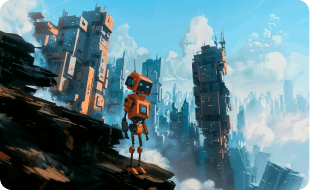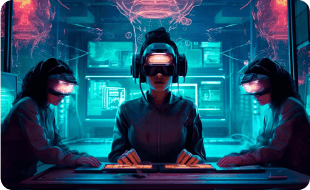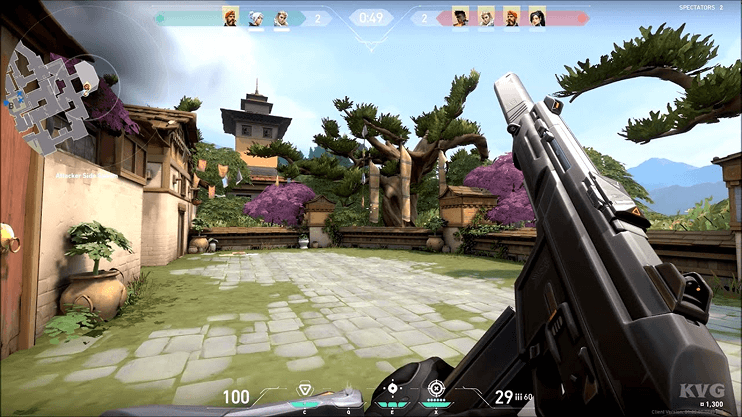
Hyper Casual Game Development
Hyper Casual Game Development Company | Crafting Addictive Hyper-Casual Games
We specialize in designing and building hyper-casual games that are lightweight, visually striking, and insanely addictive — ready to dominate the app stores. If you're dreaming of a chart-topping hit, we’re here to turn that dream into reality. Let’s build something players just can’t put down!

12+
Years of Expertise
50+
Projects Completed
10M+
Game Downloads

Our Full-Suite Hyper-Casual Game Development Services
Maintaining a constant velocity and an easy learning curve our team aims to create and develop hyper-casual games that players would enjoy. Looking for a hyper-casual game that would go viral and attract people’s attention to the game itself? You’re in the right place.

Hyper-Casual Game Design & Development
We design simple, elegant games with simple controls — games that anyone can play on the spot.

Visual Aesthetics for Hyper-Casual Games
Our designs are bright, clear, and uncluttered to engage players immediately and provide a non-cluttered interface.

AR-Enhanced Hyper-Casual Games
Looking for a way to give that edge to your hyper-casual game title? We incorporate the use of many features that give a hint of augmented reality to the game.

Multi-Device Optimization
No matter if your target is mobiles or tablets, PC and laptops, root or non-root, your hyper-casual game is crystal clear and smooth across any screens and devices.

Live Game Operations
Looking for ways to continue the energy after the launch? Our live operations are responsible for post-launch content, engaging players, and organizing in-game events.

Rapid Game Prototyping
Do you have an idea that you would like to see through? We rapidly convert your ideas into clickable prototypes and you can refine and progress with your ideas.

Game Reskinning & Rebranding
Thinking of refreshing your game for a new audience? We provide professional reskin and brand solutions to make your game brand new again.

Character and Element Design
In hyper-casual games, even a cute character or an object could make so much difference. We introduce very simple, yet prominent symbols which are loved by the players.

Smooth Animations & Visual Effects
We add shiny and smooth visuals that make your game enjoyable with each tapping, swiping, and jumping.
The Hyper Casual Game Expertise
Why Choose Our Hyper-Casual Game Development Company?
If you are seeking to have a team that has the appropriate skills in transforming concepts into popular games for the mobile devices, then this is the perfect place to start. Our team has extensive expertise in hyper casual multiplatform games with the focus on creative conception. In 2021, the hyper casual gaming market was valued at US$1.5 billion and, despite a less than optimistic 2023, Business Research Insights projects the gaming subvertical to be worth $3.6 billion by 2032.








Bring Your Hyper-Casual Game Development Vision to Life: End-to-End Development Process


Ready to Build Your Next Hyper-Casual Hit?
StrikeOneStudios is your dedicated partner in hyper-casual game development. Let’s turn your simple idea into the next mobile sensation!
Get Started

Getting Started with Hyper Casual Game Development

How Much Time Does It Take to Develop a Hyper-Casual Game?
Estimated time to create a hyper-casual game depends on the complexity and the feature set, yet generally it will take:
- Basic Hyper-Casual Games (simple mechanics, minimal levels): 2–3 months.
- Feature-Rich Hyper-Casual Games (with special effects, multiple modes, or complex progression): 4–6 months.
Hyper-casual games are designed to be fast, both in terms of the length of the gaming sessions and time taken to create them. But the fact is that making perfectly captivating loops and polished experiences still requires imaginative work and fine-tuning.
How Do Hyper-Casual Game Development Services Add Value to My Gaming Project?
- Rapid market readiness:
- Addictive gameplay design:
- Effective monetization strategies:
- Cross-platform reach:
- Post-launch growth support:
It is designed to make it easier for teams to jump to the hyper-casual genre and target popular trends at the moment.
Our focus is on creating engaging, simple to understand yet difficult to set down games that get players’ attention immediately.
With our paid placements, offers, or progression strategy, we ensure that users aren’t disrupted but you gain more bucks.
We create hyper-casual games that work on Android, iOS, Web, and mini-program environments and provide you access to a wide audience from the get-go.
Offering everything from live events and show support to ongoing feature updates, we are your long-term partner in making your game a success and your players happy.
What Are the Key Benefits of Outsourcing Hyper-Casual Game Development Services?
Presently, outsourcing hyper-casual game development is prevalent among hyper casual game developers, startups, and even large mobile gaming industries. Regardless of whether you are creating a tap-based endless runner, a fast-paced puzzle game or any other hyper-casual hit, outsourcing can prove to be very beneficial.
Access to Specialized Expertise
The primary benefit of outsourcing hyper-casual development is readily access to a pool of talent specializing in that genre.
Instead of having to recruit, train and deploy a team in-house you can hire people with experience in:
- Rapid prototyping and market testing
- Minimalistic art and UX design for hyper-casual audiences
- Monetization strategies like rewarded ads and in-game boosters
- Lightweight coding optimized for mobile performance
It saves much of the time and costs of searching for the right, small details that make a large number of experiences sharp, persuasive, and professional.
Faster Time to Market
When it comes to the hyper-casual niche, speed is of the essence. Outsourcing helps a lot to speed up the process of development significantly:
- Teams execute multiple tasks in parallel to avoid bottlenecks
- Agile methods enable quick iterations and adjustments
- Regular milestone updates keep you informed and in control
- Scalability allows you to ramp up or pivot quickly if trends shift
Starting early also makes it easier since the markets were already established and companies can then exploit any arising opportunities as it relates to the acquiring users.
Cost Efficiency
Assembling an internal hyper-casual team has a cost, from salaries to equipment, rent, and overhead expenses, and much more. Outsourcing eliminates most of these:
- No infrastructure or fixed staffing expenses
- Flexible pricing models (hourly, milestone-based, etc.) fit different budgets
- Ability to allocate funds toward marketing, UA (user acquisition), or new prototypes
This means that you can obtain development of a high quality that is well within your budget and affordable.
Flexibility and Ongoing Support
Hyper-casual trends evolve rapidly. The outsourcing partners offer flexibility that is needed:
- Fast adaptations to new gameplay mechanics or trends.
- Post-launch support like updates, LiveOps management, and event-driven engagement.
- Expertise in porting games across platforms like iOS, Android, and mini-app stores.
When looking for a partner, you’re not merely creating a game, you are creating a growth plan for the future
What Factors Influence the Cost of Hyper-Casual Game Development Services?
In order to estimate certain factors of funding while developing a hyper-casual game, it is necessary to define its main aspects. As for the hyper-casual games are even simpler than RPGs or strategy games but some factors are still contributing to the increasing cost.
- Game Type and Complexity
- Single-Mechanic Games (simple tap-to-play, endless runners) are faster and cheaper to develop.
- Feature-Rich Hyper-Casual Games (with level progression, skins, reward systems) require more time and investment.
- Platform and Device Compatibility
- Android
- iOS
- Web (HTML5 for instant games)
- Art Style and Asset Production
- Custom characters or environments.
- Eye-catching color schemes and UX/UX elements.
- Smooth animations and transitions.
- Features and Functionalities
- Rewarded video ads and monetization integrations.
- Leaderboards, achievements, and sharing options.
- Skins, boosters, and in-app purchase systems.
- Daily challenges or mission systems.
- Development Team Size and Location
- Teams from North America and Western Europe typically have higher rates.
- Outsourcing to regions like Eastern Europe, India, or Southeast Asia offers excellent quality at lower costs.
- Timeline and Production Duration
- Need for larger teams or overtime work
- Accelerated QA and optimization processes
Even among hyper-casual titles, the complexity can vary:
More features and polish mean higher costs.
Developing for multiple platforms increases expenses:
Cross-platform releases require additional optimization and testing to ensure smooth performance everywhere.
Even minimalistic designs require careful attention:
The more refined and visually striking your game, the higher the cost of asset production.
Additional functionalities raise development efforts:
Each new feature layer adds coding, integration, and QA time.
Where your development team is based significantly affects the price:
Choosing the right partner ensures you balance cost with quality and scalability.
A shorter timeline often increases costs due to:
Most hyper-casual games can be developed in 1 to 3 months, depending on complexity and number of features.
Estimated Cost Ranges
Here’s a ballpark estimate for hyper-casual game development:
- Basic Hyper-Casual Game: $5,000 – $15,000
- Hyper-Casual Game with Moderate Features: $15,000 – $40,000
- Feature-Rich Hyper-Casual Game: $40,000 – $80,000
What Should I Prepare Before Partnering with a hyper casual Game Development Service?
Starting a hyper casual game development can be lots of fun – but before you begin the actual work, there are many things which should be thoroughly prepared if you want the game to turn out as good as you envision it to be.
It’s good to compare the process of selecting a development studio to going on an expedition—they wouldn’t start the journey without a map, provisions or knowing where they are heading. If you are more prepared prior to the first meeting, the project will run nicer, will be faster and more beneficial.
Here’s everything you should prepare before reaching out to a hyper casual game development partner:
- Define Your Game Vision in Detail
- Genre: RPG, strategy, survival, action-adventure, shooter, puzzle, etc.
- Core gameplay mechanics: Combact systems, exploration, puzzle-solving, crafting, trading.
- Target platforms: PC, mobile (iOS/Android), consoles (PS5, Xbox), VR/AR devices.
- Preferred art style: Hyper-realistic, stylized, cartoonish, pixel art, isometric view.
- Build a List of Must-Have Features
- Customizable characters and avatars?
- Dynamic day/night or seasonal cycles?
- Real-time PvP multiplayer or co-op modes?
- Branching storylines based on player choices?
- Inventory management, crafting, or trading systems?
- Establish Your Budget Range and Flexibility
- Small indie games, mid-tier productions, or AAA-level expectations?
- Open to phased development (Prototype → Early Access → Full Launch)?
- Any wiggle room for post-launch support, expansions, or LiveOps?
- Curate Visual and Gameplay References
- Art styles from games like Hades (isometric) or The Witcher 3 (open-world realism).
- UI/UX designs from mobile favorites like Genshin Impact.
- Gameplay loops similar to Dark Souls or Stardew Valley.
- Prepare for Continuous, Two-Way Collaboration
- Set realistic expectations about feedback frequency and response times.
- Be open to expert suggestions based on technical feasibility and player experience.
- Actively participate in major reviews (concept art, milestone builds, beta testing).
To start with, you should decide on what exactly the main concept of your game is going to be. It is important for developers because it puts straight men into their picture; they require clear instructions.
Key points to lock down include:
If you’re not a game designer yourself, spending an hour or two to put together a vision document or a preliminary creative brief will make all the difference. This enables your 3D game development partner to have the basic structures on which they can base a game on, and it also saves time otherwise wasted in redoing the project later on.
What functionalities will define your game's experience?
When defining the features, you should separate them into the essential and non-essential ones to be able to estimate the time in more detail, determine the number of people needed, and the technologies used in your studio. This list is critical for creating the initial project backlog and proper estimation of tasks to be done with needed timeframes.
There is no exact number to start with because such a number must be part of a strategic and realistic budget range for the partnership.
Refer back to the fact that planning ensures one gets value for their money without getting exhausted midway. Additionally, they can even suggest the most suitable tools, engines – whether it's Unity or Unreal – and third-party services that match your stated budget.
Game development is an interpretive act that entails the generation of games from ideas in designers’ minds. This is completely valid as it significantly helps avoid creating misunderstandings about the desired feel of levels and general gameplay.
Helpful references could include:
The so-called ‘show and tell’ approach does not actually involve showing the developers numerous examples of what you need; instead, try to convey the general atmosphere, tone, rhythm, and feel that you want the game to achieve.
Finally, brace yourself: hyper casual game development is not a handoff—it’s an ongoing conversation.
Studios love proactive partners. Your involvement can spell the difference between a generic game and one that resonates deeply with players.
FAQ
Answers to the most frequent question.

Build Interactive Worlds with a Reliable hyper casual Game Partner
If you're ready to create bold, dynamic hyper casual experiences that captivate and inspire, we’re ready to roll up our sleeves and bring your vision to life.









